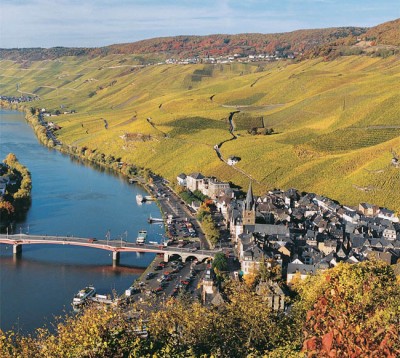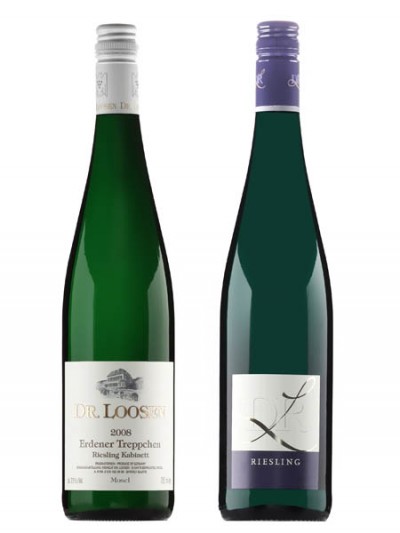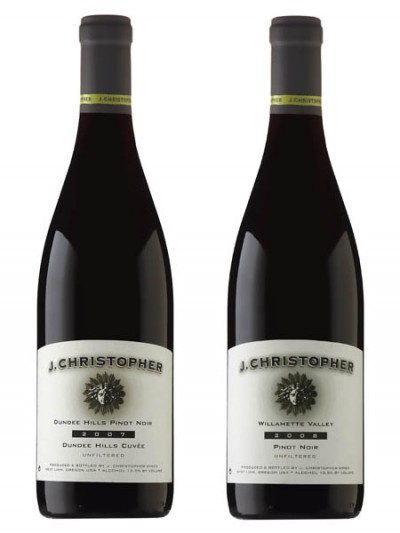There is no denying it: I really do love a good bottle of Mosel. As far as wine preferences are concerned, most of mine tend to fluctuate over time, but not Mosel – it remains a constant bright star on my heaven of wines. Hence, if superlatives abound in this article, perhaps Dr. Loosen cannot take all the credit, even though it was a bottle of their Whelener Sonnenuhr spätlese that threw me head over heels into Mosel bliss a few years back.
But what, then, is so amazing about Mosel? I can name no less than six reasons, and my list is probably not exhaustive.
First and foremost, the acidity and elegance of the main grape variety, Riesling, ensures that good wine can be made practically regardless of where the grapes are grown, and the climate and slate soil in the Mosel valley is ideal for growing Riesling.
Secondly, it’s the minerality of the wine (though shared with several other good German districts, e.g. Rheingau and parts of Nahe and Rheinhessen).
Thirdly, it’s the exciting, predictable and at the same time unpredictable aromas that appear increasingly clearly as the wine ages. Will the wine taste like rubber and diesel or not, and if so, to what extent? Will the sweetness have been “consumed” by cellaring? How much honey and dried apricots will be present on the nose and palate? Will weird and wonderful aromas like the blackcurrant flavor characteristic of top vineyards in Piesport be discernible?

Fourthly, the wine tastes amazing, young and mature alike. While shunned by many top growers, I savour the controversial petroleum notes often present in mature Mosel Riesling.
Fifthly, Mosel growers often (or even normally) dare to “sacrifice” alcohol to gain sweetness and elegance. Medium dry wines are not to everyone’s liking, obviously, but I am convinced that many people whose image of medium dry German wine was wrecked by Liebfraumilch in their teens would appreciate high quality prädikat-class wine if they only gave it a fair chance.
My sixth and final reason for loving Mosel is the perfect balance between acidity and sweetness so specific to the region, even though it also occurs in Riesling from other districts on occasion. I have even created a term for it: Moselfreude (essentially untranslatable – Mosel bliss is the best I can do). This phenomenon is hard to describe – it amounts to more than simply balance between acidity and sweetness; lots of wines are balanced in this respect but distinctly lack Moselfreude. It is as if a certain kind of acid (tartaric acid contributes, of course, but some other substance might also be involved in causing this phenomenon; however, a sensory rather than a chemical explanation could also be fathomed) in some strange way causes, as Ernst Loosen expresses it, a tension between acidity, aroma, minerality and sweetness that makes the wine exceptionally tasty.
Moselfreude
I was thrilled when Ernst Loosen (or Ernie, as he calls himself internationally for pronunciation reasons), the world famous winemaker who runs Dr. Loosen, seemed to agree with me about the existence of a particular Moselfreude. He named slate soil as its primary cause, which is a hypothesis I am not equipped to verify or falsify without getting into rather too deep water. However, the slate soil does provide the potassium which gives Mosel wine its obvious minerality, that much is undisputed. Hence, the treasured slate soil is certainly treasured for a good reason.
Ernie Loosen was our guide during the tasting that resulted in this article, a lunch tasting at restaurant Pubologi in Stockholm. The tasting was well thought-through: currently available vintages were paired with older wines from climatologically similar years. Hence, we tried the 2010 Wehlener Sonnenuhr spätlese alongside the same Prädikat and Einzellage from 1985, and vintages 1996 and 2010 of Erdener Treppchen kabinett were tasted together. Of the sweet Wehlener Sonnenuhr beerenauslese, the recently released vintage 2006 (sold at Sweden’s national liquor monopoly retailer Systembolaget since May of 2012) and 1976 were both offered.

In addition to these, a couple of pinot noirs from Dr. Loosen’s and J Christopher’s jointly owned vineyard in Oregon were also tasted, as well as a couple of entry level Rieslings. The first of these, 2011 Dr L, is neither a single vineyard nor a Prädikat wine, but the current vintage could easily be mistaken for a more highly classified wine, e.g. Kabinett trocken, due to its high quality. For this wine, exclusively good grapes grown on slate soil are purchased from different producers in the Mosel region; the wine is fermented in steel tanks and is intended to have the character of a typical Mosel Riesling. Süssreserve, e.g. sweet unfermented grape juice, is never added.
On the nose, Dr L is dominated by pear and lemon aromas with the region’s typical minerality clearly present. On the palate, the wine had an appetizing level of acitidy, nice minerality and a fresh pear flavor. As Ernie Loosen expressed it, the wine is “slightly fruity”, by which he referred to the slight residual acidity that would allow the wine to be designated feinherb. Luckily, however, the importer and producer have decided not to print this on the bottle – one of the problems with German wine in general is the complicated assortment of more or less incomprehensible classifications that tend to confuse rather than inform the average consumer.
However, it is of course important to make the consumer aware of the presence of residual sugar (in Sweden, Systembolaget publishes this information clearly). Dr L is a highly drinkable wine, perfect as an aperitif or to accompany Asian or other food where the wine’s residual sweetness is matched by sugar and/or spiciness from chili in the food.

Next, we tasted vintages 1996 and 2010 of Dr. Loosen Erdener Treppchen kabinett. The older wine was comparatively dark in colour and had typical pungent ripe Riesling aromas on the nose: dried apricot and lobster. On the palate, the wine was drier than its nose indicated and entirely without petroleum flavor. The years in question were very similar at Dr. Loosen’s vineyard in Erden, leading to very high levels of acidity (10.5 g in 1996 and 10 g in 2010), and a sugar content of about 50 g per liter for both years. However, in the older wine the sweetness had diminished considerably and the younger wine tasted much sweeter.
The 2010 Erdener Treppchen kabinett had lots of lemon and cool mineral freshness on the nose, but no pear. There was practically total Moselfreude in this wine, with a perfect balance between acidity and sweetness, a clean flavor and some spritz. In my view, Kabinett is generally the Prädikat that has the most obvious Moselfreude.
We also tasted two vintages of Dr. Loosen Wehlener Sonnenuhr spätlese, 1985 and 2010. Unlike the older Erdener Treppchen wine, however, in this case the older wine was still light in colour and still smelt comparatively young and fresh, even though there was a hint of apricot ripeness on the nose. The 1985 vintage wine also had a very elegant and appealing smoky minerality. On the nose, the wine was sweet but not painfully so, and the acidity was slightly lower than the kabinett wines. The fresh minerality of the currently available vintage, 2010, was extreme on the nose. More reminiscent of eating grape on the palate, the wine had all the properties expected of a spätlese from a top notch Einzellage, including plenty of Moselfreude. But how come the 1985 spätlese was nowhere near as ripe as the eleven years younger kabinett?
Exhange stability for natural wine production? No says Ernie.
Ernie Loosen explained that during the 1990’s, influences from mainly the USA inspired winemakers to add less sulfur to their wine. The trend to reduce additives has since spread all across the globe and become more extreme with many producers making so called natural wines, which according to their most fervent proponents should preferably not contain any additives at all. Dr. Loosen, however, decided not to move in this philosophical direction when realizing the result of reducing the amount of sulfur added, and instead went back to the old, higher levels. Ernie Loosen refuses to sacrifice the stability of the wine to win points from those advocating “natural” wine production.
In the same spätlese flight, we also sampled Dr L Bernkasteler Kurfürstlay spätlese 2010. The company’s principle is to only use the name Dr. Loosen for wines from Einzellagen, that is, single vineyard wines. Bernkasteler Kurfürstlay is a Grosslage, which is a type of division that comprises a larger area than a single vineyard. Consequently, this wine costs less and has slightly lower quality. This is not to say that the wine in question was in any way substandard, however; on the contrary, it offers the opportunity to purchase a competently made and entirely enjoyable Mosel spätlese while still not spending quite as much as you need to spend with Einzellage wines.
On the nose, this wine was typical of its origin but more subtle and with less mineral present compared with more exclusive wines. The main advantage of the other spätlese wines sampled is additional refinement and complexity due to minerality, on the nose as well as the palate. Both the Dr. Loosen Wehlener Sonnenuhr spätlese 2010 and the Dr L Bernkasteler Kurfürstlay spätlese 2010 are well worth their price – personally I am happy to spend twice as much on the former, but that is me.
Pinot Noir? Why not.
Ernie Loosen also owns a vineyard in Willamette Valley, Oregon jointly with Jay Somers, and a few samples of pinot noir from that joint venture were served with the main course. Some Germans apparently enjoy ripe Riesling with traditional game dishes, but Pubologi served contemporary gourmet food and even a Mosel maniac like me was happy to switch from Riesling to Pinot noir when meat was served. The combination offered, however, was excellent.

Unfortunately, none of the wines are currently available to Swedish consumers through the national liquor monopoly stores – the importer has not yet from a cost perspective been able to justify modifying the labels on the bottles to make them conform to the tough EU regulations regarding label information and design which the monopoly enforce strictly.
2008 J. Christopher Pinot Noir was intense and complex on the nose, with berries as well as red and dark fruit present on the nose. The scent was reminiscent of Spätburgunder, with some rather appealing aromas of damp cellar, rubber, spices and boiled vegetables. On the palate, there was a bit of tannin, fruity berries, floral notes and decent length.
2007 J. Christopher Dundee Hills Pinot Noir was riper and more elegant on the nose, with tobacco, complex fruityness, ripe berries, cigarr and fresh blackcurrant aromas present. This wine had a more stringent tannin structure and was more dominated by alcohol, but with nice fruits and berries on the palate. Grape ripeness was slightly lower in 2007 than in 2008, which was a good year that allowed grapes to ripen fully. Neither wine is filtered; there is no need since extended barrel ageing has rendered the wine sufficiently stable.
The younger wine was described by Ernie Loosen as “over-barreled”, since it was aged in oak for as long as 18 months, but I found neither wine excessively oaky. Rather, they were enjoyable and well-made wines from an interesting district. I am looking forward to tasting more Oregon wine – unfortunately only about thirty wines from Oregon are available through Systembolaget and several of these were sold out at the time of writing.

Finally, we tasted two vintages, 1976 and 2006, of Wehlener Sonnenuhr beerenauslese; that is, sweet wine made from ripe, botrytised grapes. Both vintages were made entirely from grapes affected by noble rot. The older reference vintage was beautiful and deeply yellow in colour and I found rubber, smoke and mineral on the nose, which was fresh and as expected dominated by dried apricots and honey.
The typical aromas of botrytis affected wine were naturally also present on the palate, which was fresh and had an unexpectedly low level of sweetness – in fact, it practically tasted medium dry rather than sweet. A clear example of how perceived sweetness diminishes with aging. If I hadn’t known the wine was so old I would have assumed it was and ten years younger and a lower prädikat, since the wine was still fresh and lacked dominating sweetness.
The current vintage of the same wine is 2006, which was released in the Swedish monopoly stores in the odd size 187 ml this April. Unsurprisingly, the sweetness was much more dominating in this wine, but that is not to say it is unpleasantly sweet; rather, there is plenty of balancing sweetness, resulting in a wholly enjoyable wine. This wine is still young, with citrus and (not yet dried) apricots dominating both nose and palate. Ernie Loosen described 2006 as the best vintage for sweet wine of the millennium and thinks this beerenauslese is much too young to drink now, but that is of course a matter of personal taste.
Conclusion: As it has in the past, Dr. Loosen’s easily recognizable label will continue to make my mouth water in anticipation of first-rate Moselfreude.
Peter Modin writes on wine and wine tastings in Sweden for BKWine Magazine
[box type=”info”]Inspired? Travel with BKWine Tours and experience the world of wine first hand. Read more about our wine tours on the BKWine Tours website![/box]










2 Responses